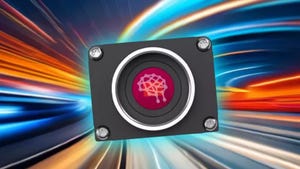Encoders Integrate Safety Technology
February 8, 2010

Newfunctional safety incremental encoders from Pepperl+Fuchs use a sine/cosineoutput interface to measure speed, rather than traditional square waves, tocreate a decentralized safety solution for use with safety speed monitoringPLCs and relays.
TheRVS58Sencoder is the first and only ISO13849 certified SinCos encoderspecifically designed for use in safety aligned systems up to SIL3 (IEC 61508,IEC62061), performance level "e" (IEC 13849). The encoders are also suitable asa motor feedback system for safe drives in accordance with IEC 61800-5-2. Functionalsafety requirements like Safe Limited Speed (SLS), Safe Torque Off (STO), SafeOperating Stop (SOS), Safe Stop (SS1, SS2), Safe Direction (SDI) and furthersafety functionality can be realized without redundant sensors.
Becausethe SinCos interface is compatible with existing safety PLC products, safetycontrollers that implement cable break detection technology and verificationchecks on the input signals can achieve the highest degree of safety. Therotary encoders also provide internal self diagnostic features to verify thecalculated output, along with additional temperature and voltage checking safediagnostic features.
Accordingto David Rubinski, a product manager for Pepperl+Fuchs, sinusoidal feedbackprovides continuous wave forms and the technology offers a mechanism to detectwire breaks, a key issue and limitation with incremental encoders.
"Whenan encoder is functioning correctly and there is no wire break, the safetydevice connected to the encoder can look at the sine-cosine waves and calculatewhether or not the signal is genuine, uninterrupted and reliable," saysRubinski. "Since sine squared plus cosine squared equals one, the connecteddevice can calculate whether or not the signal is functionally safe."
Sincethe connected system is a safe device which can calculate and verify that thetwo signals are proper, if there is anything wrong with the signal, thecontroller can determine that condition and take appropriate action. The bigproblem with using standard incremental encoders is that there are no checkmechanisms because at zero speed the square wave signal could be either high orlow. But with a SinCos encoder, the outputs can still be verified to determineif the signals are proper at zero speed.
Thebig benefit for customers is a system that offers cost and time-savings byallowing for higher machine availability and productivity. The encoders canalso be directly attached to a motor due to temperature resistance up to 115C.
TheRVS58S encoders offer 1024 or 2048 signal periods and are thermally stabilizedfor high resolution interpolation. They operate at 5V dc (A plus or minus 5 percent) anddeliver a 1 Vpp output signal up to a maximum output frequency of 200 kHz inoperating temperatures ranging from -20 to 80C. They are rated to handle axial shaft loads of 40N at a maximum of 6,000RPM or 10N at a maximum of 12,000 RPM. Maximum radial shaft loads are 60N at6,000 RPM or 20N at 12,000 RPM.
Targetedapplications for this new safe encoder technology include motor and drive speedmonitoring, elevators, theater stage equipment, cranes, storage robots andprinting.
Encoders Integrate Safety Technology A
About the Author(s)
You May Also Like





